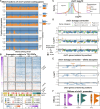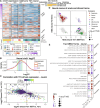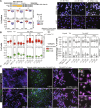A dynamic in vitro model of Down syndrome neurogenesis with trisomy 21 gene dosage correction
- PMID: 38848354
- PMCID: PMC11160455
- DOI: 10.1126/sciadv.adj0385
A dynamic in vitro model of Down syndrome neurogenesis with trisomy 21 gene dosage correction
Abstract
Excess gene dosage from chromosome 21 (chr21) causes Down syndrome (DS), spanning developmental and acute phenotypes in terminal cell types. Which phenotypes remain amenable to intervention after development is unknown. To address this question in a model of DS neurogenesis, we derived trisomy 21 (T21) human induced pluripotent stem cells (iPSCs) alongside, otherwise, isogenic euploid controls from mosaic DS fibroblasts and equipped one chr21 copy with an inducible XIST transgene. Monoallelic chr21 silencing by XIST is near-complete and irreversible in iPSCs. Differential expression reveals that T21 neural lineages and iPSCs share suppressed translation and mitochondrial pathways and activate cellular stress responses. When XIST is induced before the neural progenitor stage, T21 dosage correction suppresses a pronounced skew toward astrogenesis in neural differentiation. Because our transgene remains inducible in postmitotic T21 neurons and astrocytes, we demonstrate that XIST efficiently represses genes even after terminal differentiation, which will empower exploration of cell type-specific T21 phenotypes that remain responsive to chr21 dosage.
Figures








Similar articles
-
Analysis of genotype effects and inter-individual variability in iPSC-derived trisomy 21 neural progenitor cells.Hum Mol Genet. 2025 Jan 23;34(1):85-100. doi: 10.1093/hmg/ddae160. Hum Mol Genet. 2025. PMID: 39533854
-
Generation of Urine-Derived Induced Pluripotent Stem Cells and Cerebral Organoids for Modeling Down Syndrome.Stem Cell Rev Rep. 2023 May;19(4):1116-1123. doi: 10.1007/s12015-022-10497-8. Epub 2023 Jan 18. Stem Cell Rev Rep. 2023. PMID: 36652145
-
Increased endothelial sclerostin caused by elevated DSCAM mediates multiple trisomy 21 phenotypes.J Clin Invest. 2024 Jun 3;134(11):e167811. doi: 10.1172/JCI167811. J Clin Invest. 2024. PMID: 38828726 Free PMC article.
-
A systematic review of speech, language and communication interventions for children with Down syndrome from 0 to 6 years.Int J Lang Commun Disord. 2022 Mar;57(2):441-463. doi: 10.1111/1460-6984.12699. Epub 2022 Feb 22. Int J Lang Commun Disord. 2022. PMID: 35191587
-
Genomics-based non-invasive prenatal testing for detection of fetal chromosomal aneuploidy in pregnant women.Cochrane Database Syst Rev. 2017 Nov 10;11(11):CD011767. doi: 10.1002/14651858.CD011767.pub2. Cochrane Database Syst Rev. 2017. PMID: 29125628 Free PMC article.
Cited by
-
Consequences of trisomy 21 for brain development in Down syndrome.Nat Rev Neurosci. 2024 Nov;25(11):740-755. doi: 10.1038/s41583-024-00866-2. Epub 2024 Oct 8. Nat Rev Neurosci. 2024. PMID: 39379691 Free PMC article. Review.
-
Trisomy silencing by XIST: translational prospects and challenges.Hum Genet. 2024 Jul;143(7):843-855. doi: 10.1007/s00439-024-02651-8. Epub 2024 Mar 9. Hum Genet. 2024. PMID: 38459355 Free PMC article. Review.
References
-
- Capone G. T., Chicoine B., Bulova P., Stephens M., Hart S., Crissman B., Videlefsky A., Myers K., Roizen N., Esbensen A., Peterson M., Santoro S., Woodward J., Martin B., Smith D., Co-occurring medical conditions in adults with Down syndrome: A systematic review toward the development of health care guidelines. Am. J. Med. Genet. A 176, 116–133 (2018). - PubMed
-
- Kazuki Y., Gao F. J., Li Y., Moyer A. J., Devenney B., Hiramatsu K., Miyagawa-Tomita S., Abe S., Kazuki K., Kajitani N., Uno N., Takehara S., Takiguchi M., Yamakawa M., Hasegawa A., Shimizu R., Matsukura S., Noda N., Ogonuki N., Inoue K., Matoba S., Ogura A., Florea L. D., Savonenko A., Xiao M., Wu D., Batista D. A. S., Yang J., Qiu Z., Singh N., Richtsmeier J. T., Takeuchi T., Oshimura M., Reeves R. H., A non-mosaic transchromosomic mouse model of down syndrome carrying the long arm of human chromosome 21. eLife 9, e56223 (2020). - PMC - PubMed
-
- Kazuki Y., Gao F. J., Yamakawa M., Hirabayashi M., Kazuki K., Kajitani N., Miyagawa-Tomita S., Abe S., Sanbo M., Hara H., Kuniishi H., Ichisaka S., Hata Y., Koshima M., Takayama H., Takehara S., Nakayama Y., Hiratsuka M., Iida Y., Matsukura S., Noda N., Li Y., Moyer A. J., Cheng B., Singh N., Richtsmeier J. T., Oshimura M., Reeves R. H., A transchromosomic rat model with human chromosome 21 shows robust Down syndrome features. Am. J. Hum. Genet. 109, 328–344 (2022). - PMC - PubMed
MeSH terms
Substances
Grants and funding
LinkOut - more resources
Full Text Sources
Medical
Molecular Biology Databases
Research Materials

